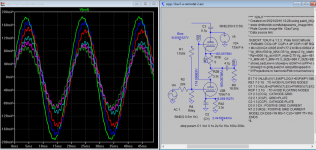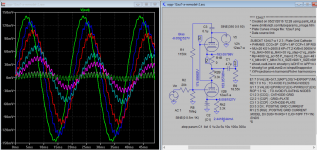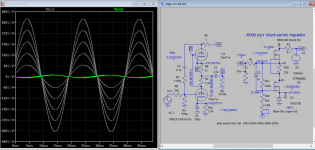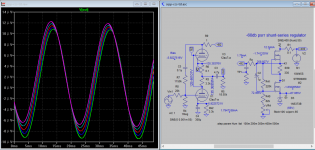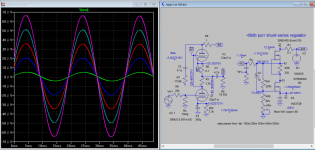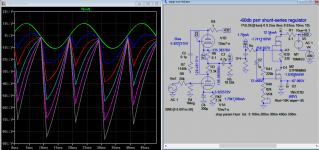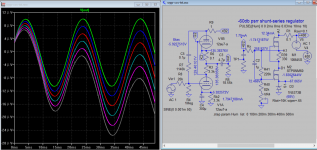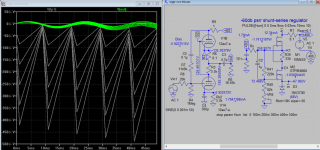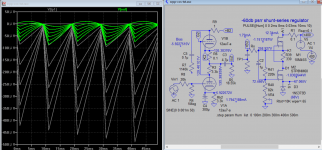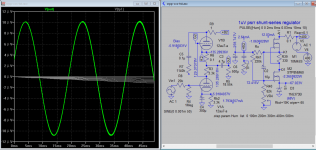I like slopes, inflection points and occasionally a nice maximum or minimum
Popilin,
Formulas are often too simple, as in simplified with too many assumptions and variables canceling out. Formulas are static; they do not show all the dynamically moving parts. Simulations are an improvement; however the SPICE models have their own simplified formulas built in.
If you look in the old musty text books the greybeards will tell you the assumptions and then provide a formula.
I am not calling Merlin a greybeard. Merlin does a good job in his books and papers presenting the theory, stating the assumptions and then the simplified formula. After all that Merlin presents his hands on created graphs and charts.
The real world charts and graphs do more for me than the simple formulas. My brain thinks in simple calculus. I like slopes, inflection points and occasionally a nice maximum or minimum. For the SRPP the distortion minimizing notch is a fine example.
DT
Popilin,
Formulas are often too simple, as in simplified with too many assumptions and variables canceling out. Formulas are static; they do not show all the dynamically moving parts. Simulations are an improvement; however the SPICE models have their own simplified formulas built in.
If you look in the old musty text books the greybeards will tell you the assumptions and then provide a formula.
I am not calling Merlin a greybeard. Merlin does a good job in his books and papers presenting the theory, stating the assumptions and then the simplified formula. After all that Merlin presents his hands on created graphs and charts.
The real world charts and graphs do more for me than the simple formulas. My brain thinks in simple calculus. I like slopes, inflection points and occasionally a nice maximum or minimum. For the SRPP the distortion minimizing notch is a fine example.
DT
DT
Reality is often very complex, then, doing a reasonable approach you must make some assumptions in order to simplify things, then theory emerges in the form of equations.
The beauty of equations is that you can predict some events, let me remind you that your measurements was predicted by equations, better or worse depends on accuracy of mathematical models and equations used.
Some people who knows a lot about LTspice, told me that differences in simulations (with the coupling capacitor) are due to DC drift, anyway some predictions were amazingly accurate.
Reality is often very complex, then, doing a reasonable approach you must make some assumptions in order to simplify things, then theory emerges in the form of equations.
The beauty of equations is that you can predict some events, let me remind you that your measurements was predicted by equations, better or worse depends on accuracy of mathematical models and equations used.
Some people who knows a lot about LTspice, told me that differences in simulations (with the coupling capacitor) are due to DC drift, anyway some predictions were amazingly accurate.
😛😀Theory is when you know everything but nothing works.
Practice is when everything works and nobody knows why.
In our laboratory, combine theory and practice:
Nothing works and nobody knows why.
Hello Popilin,
I spent some time reading White Cathode Followers over at tubecad.com. WCF’s also operate in push pull. They operate with similar theory and similar magic formulas to optimize the balance of push pull operation.
The discussion of WCF’s says that power supply ripple is much reduced at the output when the push pull balance is optimized.
We have discussed the improved distortion performance of optimized SRPP amplifiers. This has set me to wondering about the PSRR performance of a SRPP as the Push Pull balance is optimized.
What do you say? Will you take one of those LTSPICE simulations and add 500mv of AC ripple to the HT supply and see what happens to the power supply rejection ratio as the circuit moves through the optimization notch.
Thanks
DT
I spent some time reading White Cathode Followers over at tubecad.com. WCF’s also operate in push pull. They operate with similar theory and similar magic formulas to optimize the balance of push pull operation.
The discussion of WCF’s says that power supply ripple is much reduced at the output when the push pull balance is optimized.
We have discussed the improved distortion performance of optimized SRPP amplifiers. This has set me to wondering about the PSRR performance of a SRPP as the Push Pull balance is optimized.
What do you say? Will you take one of those LTSPICE simulations and add 500mv of AC ripple to the HT supply and see what happens to the power supply rejection ratio as the circuit moves through the optimization notch.
Thanks
DT
Hi DT
As far as I know, PSRR performance of SRPP is quite poor, around -6dB, nevertheless this should not be a problem if your PSU is good enough. 😉
500mV is a lot of ripple, even for a simulation, indeed, results are horrible. 😛😀
As far as I know, PSRR performance of SRPP is quite poor, around -6dB, nevertheless this should not be a problem if your PSU is good enough. 😉
500mV is a lot of ripple, even for a simulation, indeed, results are horrible. 😛😀
Hi DT
As far as I know, PSRR performance of SRPP is quite poor, around -6dB, nevertheless this should not be a problem if your PSU is good enough. 😉
500mV is a lot of ripple, even for a simulation, indeed, results are horrible. 😛😀
Yes SRPP typically has a not so good PSRR. The white cathode follower is in the same boat. However the WCF has a much improved PSRR when the Push Pull is in critical balance.
My question, is this also true for the SRPP?
yes 500mv is dramatic. If there is any reduction in ripple at critically balance of Push Pull it will also be dramatic in the simulation, us less ripple if you like.
PSRR of SRPP improved somewhat as usual when the cathode is bypassed as well as this sim here shows. According to the sim, PSRR is greatly improved if Broskie type of PSRR mod is added and null occurred, and similar calculations of RC pairs maybe applied. A minor change of load or cathode resistance does not affect the PSRR much.
Attachments
Here are another 2 sims for study purpose only, as the PSU ripple is never sinusoidal in practice, wish I can find one closer to real ripple.
Attachments
Last edited:
To sim PSRR just add a voltage source in series with the power supply dc voltage. Set it to 1V and do an ac sweep. Make sure you set the normal ac input voltage to zero or just remove it.
As a rule, the PSRR of an SRPP is about equal to the mu of the top tube. I am not sure why people say the the PSRR of an SRPP is bad. Compared to an op amp it is bad but the PSRR of a regular common cathode stage is much worse.
I am not sure why people worry about PSRR in preamps. It is not hard to build an HT supply with ripple below a microvolt.
Cheers
Ian
As a rule, the PSRR of an SRPP is about equal to the mu of the top tube. I am not sure why people say the the PSRR of an SRPP is bad. Compared to an op amp it is bad but the PSRR of a regular common cathode stage is much worse.
I am not sure why people worry about PSRR in preamps. It is not hard to build an HT supply with ripple below a microvolt.
Cheers
Ian
For an unbypassed, unloaded SRPP (probably how 90% of people build them) PSRR is only about 6dB...I am not sure why people say the the PSRR of an SRPP is bad.
+1. I've seenmany posts on Broskie's blog where he goes to extreme lengths to improve PSRR, but ends up making the self-noise far worse instead. People get fixated on certain performance metrics and forget how to see the wood among the trees! 🙄I am not sure why people worry about PSRR in preamps. It is not hard to build an HT supply with ripple below a microvolt.
Thank you Ian (ruffrecords). I manage to series a ripple source of 100/120 hz with the DC. Again the results here are for study purposes.
Attachments
For an unbypassed, unloaded SRPP (probably how 90% of people build them) PSRR is only about 6dB...
The I guess 90% of people are building them wrongly. 🙄
Cheers
Ian
For an unbypassed, unloaded SRPP (probably how 90% of people build them) PSRR is only about 6dB...
+1. I've seenmany posts on Broskie's blog where he goes to extreme lengths to improve PSRR, but ends up making the self-noise far worse instead. People get fixated on certain performance metrics and forget how to see the wood among the trees! 🙄
Hello Merlin,
I believe that John Broskie is mindful of what he is posting in his blog. As many posts as he has posted I get the feeling that it much like spit wads, some percentage will stick to the wall some will not. In each post I hear him saying, what about this one? He does it for some sort of fun, not for the pursuit of perfection. John does cause us to think; sometimes we may say that he is way off base, sometimes we say “right on”.
I enjoy your theoretical and practical hands on application in your articles and books. You are more about building things that work.
Thanks.
Back to the topic.
Looks like the consensus is that an optimized un-bypassed SRPP does not do any magical reduction of power supply noise.
DT
Hi DT, Thank you for sharing, I am sorry for your PSU by the way.
Hope it will be repaired soon for more results. 😉😛
Then, so far very close to the 9AU7. 😕
Some people must not be very happy about this. 😛😀
Indeed, in Merlin's article
Rk optimum = (2 Rload + Ra) / (μ - 1)
Amazing article BTW, full of equations, I like equations very much.
Agree.
Hello Popilin,
Over the past month I have been putting together a new computer with MATLAB installed, this bench automation is coming together. I have a box full of old school National Instruments PXI, instrument cards communicating with and controlled by by MATLAB. The plan is to collect empirical data, do some curve fitting and see how the data plots compare to the formulas we play with. MATLAB or excel will do the curve fitting.
Today I went to the Keysight repair facility and picked up the repaired 600 volt power supply. The power supply is up, running and freshly calibrated.
The PC GPIB card seems to be alive and alert, next we see if we communicate with and control the power supply.
DT
Last edited:
I am not familiar with MATLAB, but if you want to do serious data analysis SigmaPlot or TableCurve are very useful. 😉
I am not familiar with MATLAB, but if you want to do serious data analysis SigmaPlot or TableCurve are very useful. 😉
MATLAB plays in the same sand box as LabView.
Both MATLAB and LabView are very expensive. LabView would not budge on the price. MATLAB, because I teach at the local community college and will not use the software for profit, allowed me to use the Student price. I could not pay many thousands of dollars for either.
DT
- Status
- Not open for further replies.
- Home
- Amplifiers
- Tubes / Valves
- Yet another ECC82/12AU7 Line Preamp
